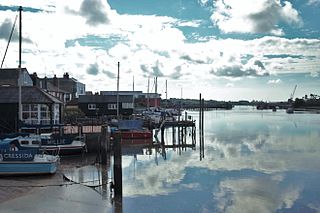
Richard Boyle, 3rd Earl of Burlington and 4th Earl of Cork, was a British architect and noble often called the "Apollo of the Arts" and the "Architect Earl". The son of the 2nd Earl of Burlington and 3rd Earl of Cork, Burlington never took more than a passing interest in politics despite his position as a Privy Counsellor and a member of both the British House of Lords and the Irish House of Lords. His great interests in life were architecture and landscaping, and he is remembered for being a builder and a patron of architects, craftsmen and landscapers, Indeed, he is credited with bringing Palladian architecture to Britain and Ireland. His major projects include Burlington House, Westminster School, Chiswick House and Northwick Park.

Wivenhoe is a town and civil parish in the Colchester district, in north-eastern Essex, England, approximately 3 miles (5 km) south-east of Colchester. Historically Wivenhoe village, on the banks of the River Colne, and Wivenhoe Cross, on the higher ground to the north, were two separate settlements; however, with considerable development in the 19th century, the two have since merged.

Wivenhoe Park is a landscaped green space of more than 200 acres (81 ha) at the eastern edge of Colchester, England. It is the site of Wivenhoe House, a four-star hotel, based in an eighteenth-century Grade II listed house. Wivenhoe House is also home to the Edge Hotel School, the first school of its kind in the UK and since October 2018 a department of the University of Essex. Since the 1960s, Wivenhoe Park has also been home to the Colchester Campus of the University of Essex.
Thomas Hopper (1776–1856) was an English architect of the late 18th and early 19th centuries, much favoured by King George IV, and particularly notable for his work on country houses across southern England, with occasional forays further afield, into Wales and Ireland.

Alresford is a village and electoral ward in Essex, England. It is centred 9 km (5.6 mi) southeast of Colchester and is 39 km (24 mi) northeast from the county town of Chelmsford. The village and its civil parish are the district of Tendring. The local primary school is Alresford Primary School and the village has a pre-school and church. Alresford won the Essex Village of the year competition in 2012 and tied for first place for another Essex Village of the Year award in 2019.

Hylands House is a Grade II* neo-classical villa situated within Hylands Park a 232-hectare park southwest of Chelmsford in Essex in South East England. It is owned and operated by Chelmsford City Council.
The High Steward of Colchester is a ceremonial office awarded by Colchester City Council, Essex, England.
Edward Prioleau Warren was a British architect and archaeologist.

Craigiehall is a late-17th-century country house, which until 2015 served as the Headquarters of the British Army in Scotland. It is located close to Cramond, around 9 km (5.6 mi) west of central Edinburgh, Scotland.

Gurdon Wallace Wattles was an early businessman, banker, and civic leader in Omaha, Nebraska, who became responsible for bankrolling much of early Hollywood. Wattles was said to possess "all the right credentials to direct Omaha's fortunes for the twentieth century in the post-pioneer era: humble beginnings, outstanding ability, a fine intellect, impeccable manners, driving ambition, and a ruthless streak."

Crewe Hall is a Jacobean mansion located near Crewe Green, east of Crewe, in Cheshire, England. Described by Nikolaus Pevsner as one of the two finest Jacobean houses in Cheshire, it is listed at grade I. Built in 1615–36 for Sir Randolph Crewe, it was one of the county's largest houses in the 17th century, and was said to have "brought London into Cheshire".

John Gurdon Rebow was an English Liberal Party politician who sat in the House of Commons in two periods between 1857 and 1870.

Wivenhoe Park is a painting of an English landscape park, the estate of the Rebow family, by the English Romantic painter, John Constable (1776–1837).

Isaac Martin Rebow was a British landowner and politician who sat in the House of Commons between 1755 and 1781.
Matthew Martin (1676-1749) of Alresford Hall, Essex, was an East India Company mariner and politician who sat in the House of Commons between 1722 and 1742.
Bryan Keith Thomas was an English architect in Essex, known for domestic architecture in that county such as the house at Beth Chatto Gardens in Elmstead Market. His church architecture included Church of England, Christian Scientist and Quaker places of worship.
Sir Isaac Rebow was a clothier and merchant who served as Member of Parliament for Colchester in the late seventeenth and early eighteenth centuries.

General Francis Slater Rebow was a British Army officer and patron of the artist John Constable. Having joined the army in 1787, he served with the 60th Regiment of Foot in the West Indies, fighting at the start of the French Revolutionary Wars in the Battle of Martinique and Invasion of Guadeloupe, being severely wounded in the latter. In 1796 he returned home, marrying the daughter of Isaac Martin Rebow and taking the Rebow surname as his own.

Harwich Lighthouse is an 1820 landscape painting by the British painter John Constable. It depicts a scene on the coast of Essex in England featuring Harwich Low Lighthouse. The lighthouse was maintained by Constable's patron General Rebow whose estate at Wivenhoe Park he also painted.

The Quarters behind Alresford Hall is an 1816 landscape painting by the English artist John Constable. It depicts a fishing lodge at Alresford Hall near the Essex village of Alresford. The Hall was owned by the Regency era General Francis Slater Rebow. Constable was also commissioned to produce a work of another of his properties Wivenhoe Park the same year. The lodge at Alresford, known as The Quarters, was designed for banqueting and was located at the side of the lake in the grounds.














